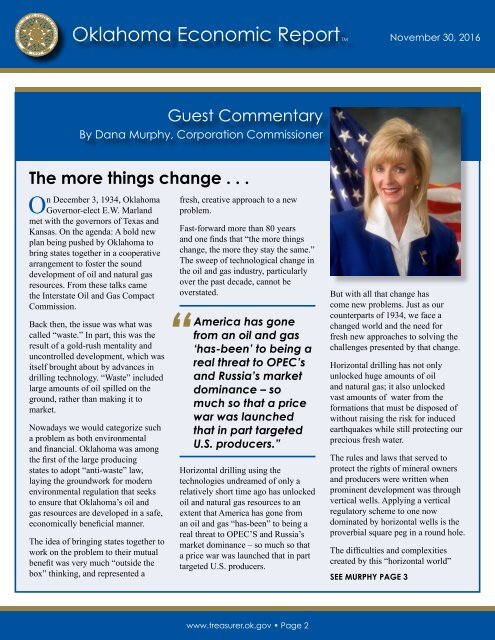“When
x8QZh
x8QZh
You also want an ePaper? Increase the reach of your titles
YUMPU automatically turns print PDFs into web optimized ePapers that Google loves.
Oklahoma Economic Report TM November 30, 2016<br />
Guest Commentary<br />
By Dana Murphy, Corporation Commissioner<br />
The more things change . . .<br />
On December 3, 1934, Oklahoma<br />
Governor-elect E.W. Marland<br />
met with the governors of Texas and<br />
Kansas. On the agenda: A bold new<br />
plan being pushed by Oklahoma to<br />
bring states together in a cooperative<br />
arrangement to foster the sound<br />
development of oil and natural gas<br />
resources. From these talks came<br />
the Interstate Oil and Gas Compact<br />
Commission.<br />
Back then, the issue was what was<br />
called “waste.” In part, this was the<br />
result of a gold-rush mentality and<br />
uncontrolled development, which was<br />
itself brought about by advances in<br />
drilling technology. “Waste” included<br />
large amounts of oil spilled on the<br />
ground, rather than making it to<br />
market.<br />
Nowadays we would categorize such<br />
a problem as both environmental<br />
and financial. Oklahoma was among<br />
the first of the large producing<br />
states to adopt “anti-waste” law,<br />
laying the groundwork for modern<br />
environmental regulation that seeks<br />
to ensure that Oklahoma’s oil and<br />
gas resources are developed in a safe,<br />
economically beneficial manner.<br />
The idea of bringing states together to<br />
work on the problem to their mutual<br />
benefit was very much “outside the<br />
box” thinking, and represented a<br />
fresh, creative approach to a new<br />
problem.<br />
Fast-forward more than 80 years<br />
and one finds that “the more things<br />
change, the more they stay the same.”<br />
The sweep of technological change in<br />
the oil and gas industry, particularly<br />
over the past decade, cannot be<br />
overstated.<br />
“America has gone<br />
from an oil and gas<br />
‘has-been’ to being a<br />
real threat to OPEC’s<br />
and Russia’s market<br />
dominance – so<br />
much so that a price<br />
war was launched<br />
that in part targeted<br />
U.S. producers.”<br />
Horizontal drilling using the<br />
technologies undreamed of only a<br />
relatively short time ago has unlocked<br />
oil and natural gas resources to an<br />
extent that America has gone from<br />
an oil and gas “has-been” to being a<br />
real threat to OPEC’S and Russia’s<br />
market dominance – so much so that<br />
a price war was launched that in part<br />
targeted U.S. producers.<br />
But with all that change has<br />
come new problems. Just as our<br />
counterparts of 1934, we face a<br />
changed world and the need for<br />
fresh new approaches to solving the<br />
challenges presented by that change.<br />
Horizontal drilling has not only<br />
unlocked huge amounts of oil<br />
and natural gas; it also unlocked<br />
vast amounts of water from the<br />
formations that must be disposed of<br />
without raising the risk for induced<br />
earthquakes while still protecting our<br />
precious fresh water.<br />
The rules and laws that served to<br />
protect the rights of mineral owners<br />
and producers were written when<br />
prominent development was through<br />
vertical wells. Applying a vertical<br />
regulatory scheme to one now<br />
dominated by horizontal wells is the<br />
proverbial square peg in a round hole.<br />
The difficulties and complexities<br />
created by this “horizontal world”<br />
SEE MURPHY PAGE 3<br />
www.treasurer.ok.gov • Page 2



